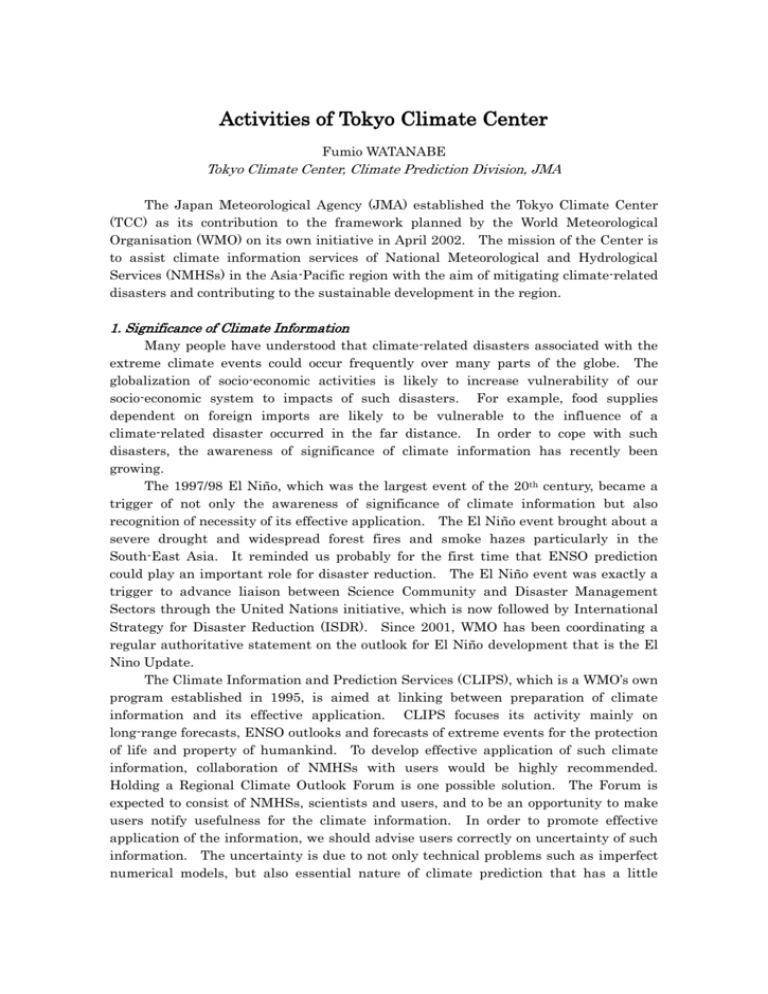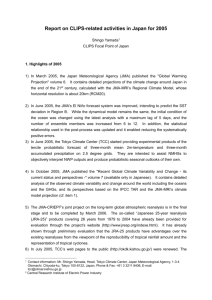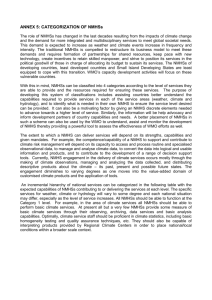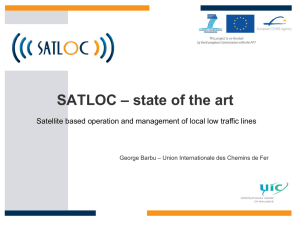TCC_activities
advertisement

Activities of Tokyo Climate Center Fumio WATANABE Tokyo Climate Center, Climate Prediction Division, JMA The Japan Meteorological Agency (JMA) established the Tokyo Climate Center (TCC) as its contribution to the framework planned by the World Meteorological Organisation (WMO) on its own initiative in April 2002. The mission of the Center is to assist climate information services of National Meteorological and Hydrological Services (NMHSs) in the Asia-Pacific region with the aim of mitigating climate-related disasters and contributing to the sustainable development in the region. 1. Significance of Climate Information Many people have understood that climate-related disasters associated with the extreme climate events could occur frequently over many parts of the globe. The globalization of socio-economic activities is likely to increase vulnerability of our socio-economic system to impacts of such disasters. For example, food supplies dependent on foreign imports are likely to be vulnerable to the influence of a climate-related disaster occurred in the far distance. In order to cope with such disasters, the awareness of significance of climate information has recently been growing. The 1997/98 El Niño, which was the largest event of the 20th century, became a trigger of not only the awareness of significance of climate information but also recognition of necessity of its effective application. The El Niño event brought about a severe drought and widespread forest fires and smoke hazes particularly in the South-East Asia. It reminded us probably for the first time that ENSO prediction could play an important role for disaster reduction. The El Niño event was exactly a trigger to advance liaison between Science Community and Disaster Management Sectors through the United Nations initiative, which is now followed by International Strategy for Disaster Reduction (ISDR). Since 2001, WMO has been coordinating a regular authoritative statement on the outlook for El Niño development that is the El Nino Update. The Climate Information and Prediction Services (CLIPS), which is a WMO’s own program established in 1995, is aimed at linking between preparation of climate information and its effective application. CLIPS focuses its activity mainly on long-range forecasts, ENSO outlooks and forecasts of extreme events for the protection of life and property of humankind. To develop effective application of such climate information, collaboration of NMHSs with users would be highly recommended. Holding a Regional Climate Outlook Forum is one possible solution. The Forum is expected to consist of NMHSs, scientists and users, and to be an opportunity to make users notify usefulness for the climate information. In order to promote effective application of the information, we should advise users correctly on uncertainty of such information. The uncertainty is due to not only technical problems such as imperfect numerical models, but also essential nature of climate prediction that has a little predictable information. 2. Backgrounds of Tokyo Climate Center There are three motivating backgrounds for the establishment of TCC. The first background is the growing awareness of significance of climate information and necessity of its effective application as introduced in the last section. As the second background, the WMO has been proposing to construct an international cooperation framework for advanced climate information services in the world (Fig.1). While NMHSs should be responsible for the provision of climate information to users in their own countries, some NMHSs would benefit from the transfer of technological capabilities to enable them to advance their climate services. In this framework, the Regional Climate Center (RCC) is intended to be a hub for climate-related activities in each region. The global producing Centres are expected for operation of a global model and operational preparation of global products, and provision of those products to RCCs and NMHSs. Users Climate Information NMHSs Products Global Producing Centres Global SI Products Data, Feedback Technical Assistance Regional Climate Centres ・ Operational activities Tailored Products Operational Preparation ・ Data services Provision ・ Capacity building activities Verification ・ Research and Development Improvement Fig.1 WMO Framework for Advanced Climate Service ・ Coordination functions The third background is the recent technical development, especially in climate modelling, which have enabled NMHSs to provide the advanced climate information services as substantial benefits for end-users. JMA introduced an ensemble prediction system into its operational one-month forecast in 1996, El Niño outlook in 1999, and three-month and cold/warm season outlooks in 2003. JMA has developed an Integrated Climate Information Production System (ICIPS, Fig.2), consisting of Dynamical Climate Prediction System (DCPS), Climate Data Assimilation System (CDAS), Ocean Data Assimilation System (ODAS) and Database/ Reanalysis System. Fig.2 Integrated Climate Information Production System in JMA The DCPS has two components, that is, an El Niño prediction system with a coupled ocean-atmosphere model and an ensemble prediction system with a global atmosphere model. JMA has been developing the Japanese 25-year Re-Analysis project (JRA-25) since 2001. 3. Tasks of Tokyo Climate Center Fig.3 indicates a schematic illustration for tasks of TCC. Each NMHS should be responsible for the provision of tailored climate information to users in its own country. For that purpose, it is expected that each NMHS could arrange basic climate data and products, and process those to the climate information meeting each country’s needs. As the first task, TCC provides the basic climate data and products, such as dynamical prediction outputs and an ENSO outlook to NMHSs. Those basic climate data and products are prepared in the ICIPS as mentioned in the last section. As the second task, TCC holds workshops and training courses as capacity building activities. The activities of TCC are aimed at assisting the development of the climate service capability in each NMHS in the Asia-Pacific region. It is noted that TCC intends to undertake functions of both a Global Producing Centre and a Regional Climate Centre in the WMO’s planning framework. Tasks of TCC/JMA Monitoring of Global Climate System Global Dynamical Prediction Monitoring of Extreme Events Regional Climate Outlook Forum Promotion of Application of Climate Information ENSO Outlook Technical Assistance Preparation and Provision of Basic Climate Information Capacity Building Activities NMHSs NMHSs in in the the AsiaAsiaPacific Pacific Climate Data Feedback Fig.3 Schematic illustration for Tasks of Tokyo Climate Center Preparation of long-range forecasts from dynamical prediction outputs and effective application of the forecasts to users should be based on correct understanding of the uncertainty. TCC could contribute to spread such correct understanding to the public in the region through each NMHS or a meeting such as a Regional Climate Outlook Forum. Such an activity would be expected for promotion of appropriate application of climate information in this region in the future. 4. Data and Products available from Tokyo Climate Center The followings are freely available from a TCC web site except for GPVs of numerical ensemble prediction, access of which requires a user ID and a password. 1. Monitoring Report on the global climate and extreme events A summary report and distribution maps of global temperature anomalies and precipitation ratios, and global extreme climate events are issued every week and every month. 2. Monitoring Report on the Global Climate System A summary report on extra-tropical and tropical circulation, convection, and oceanographic conditions is issued every month. Maps of geopotential height, cross sections of zonal mean wind and temperature, and tables of atmospheric and oceanic monitoring indices are included. Regular reports on Asian Monsoon Monitoring and Stratospheric Circulation Monitoring are also issued every five-day or every week. 3. El Niño-Southern Oscillation Outlook A current diagnosis report and an El Niño outlook are issued every month. Distribution maps of SST and anomalies in the Pacific Ocean, depth-longitude cross sections of subsurface temperature and anomalies along the equator in the Pacific Ocean, ENSO monitoring indices are updated every month. 4. Numerical Ensemble Prediction Products Ensemble prediction maps and GPVs are updated weekly for one-month prediction and monthly for three-month prediction. Verification charts of one-month and three-month ensemble prediction are also available. 5. Concluding Remarks 1. There is the growing awareness of significance of climate information. Many people are eager for receiving more accurate and timely climate information in order to cope with climate-related disasters. However the climate information such as long-range forecasts is accompanied with the inevitable uncertainty. For effective application of the information we must remind users correctly the uncertainty of the information. How to apply climate information effectively and appropriately is a difficult but an important issue. 2. JMA continues to develop and improve the ICIPS, which serves to prepare useful diagnostic and prognostic products for the advanced climate information services. 3. To promote effective application of climate information service, each NMHS should construct a structure for preparing and delivering of climate information and an international cooperation framework should be established to assist each NMHS climate information service. TCC will contribute to the framework in order to assist the development of the climate information service capability of each NMHS. 4. TCC will continue to provide the basic climate data and products from the ICIPS. And data and products available from the TCC web site will be increased and improved according to requirements of users. TCC will continue to hold workshops and training courses as capacity building activities. And TCC would contribute to promotion of effective application of climate information in the region.








